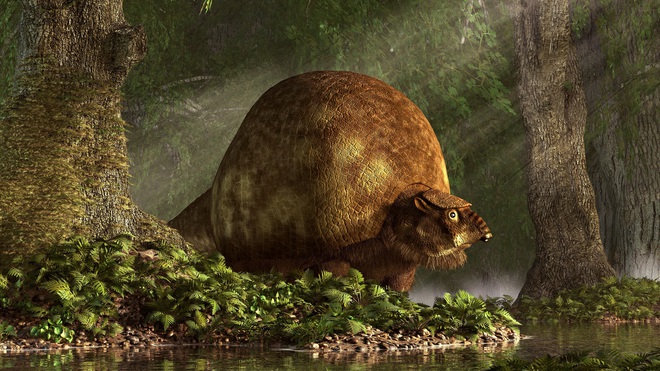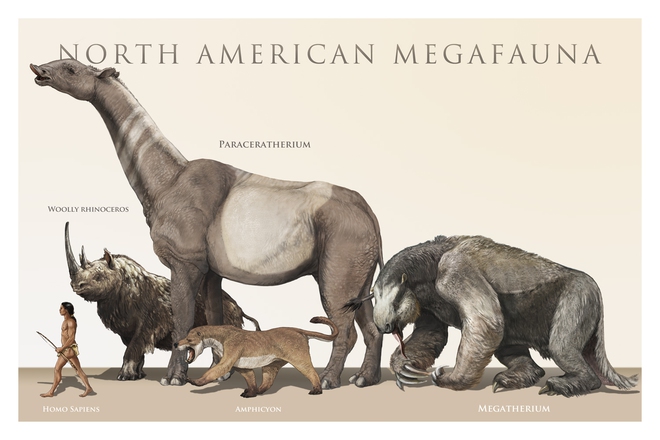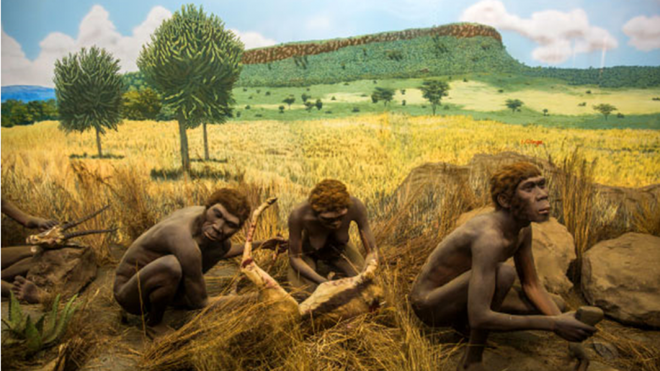Ever since modern humans (Homo sapiens) appeared, we have left our footprints all over the planet. With his upright posture and hands freed from the ground, man was able to use tools, create agriculture, transform the world, and build the cities of today.
But with that same hand, we have killed and extinct many species of plants and animals. One estimate shows that humans have increased the rate of extinction of species on Earth by 100 times.
The presence of Homo sapiens is equivalent to the extinction event in the Cretaceous-Paleolithic period, when a meteorite wiped out 80% of animals, including dinosaurs, 66 million years ago.
In other words, humans have hit the planet like an asteroid, and the dust we leave behind is still settling as wildlife populations continue to decline.
So what if humans never existed?

Instead of being as small as a soccer ball, tatu in a world without humans could be as large as a car.
“I think the Earth will have more trees with a multitude of large animals, living on all continents except Antarctica.“, said Associate Professor Trevor Worthy, a paleontologist at Flinders University, Australia. You will see dragonflies up to 1 meter long, giant turtles weighing over 1 ton and of course elephants. mammoth.
But there is another possibility, that the disappearance of Homo sapiens will pave the way for other human species like Neanderthals to dominate the planet and take power. So maybe that world wouldn’t be very different, except sitting in a BMW in Europe right now was a Neanderthal man in a suit, with a wide mouth and huge nose.
Let’s see how both of those possibilities can happen.
An Earth like the Serengeti
Sören Faurby, a senior lecturer in zoology at the University of Gothenburg, Sweden, said that humans are the animals responsible for the disappearance of many other animals, especially large mammals that have disappeared. extinct within the last 1,000 years.
In 2015, Faurby led a study published in the journal Diversity and Distributions that confirmed that without the presence of humans, the entire Earth would still be as pristine as the Serengeti region in northern Tanzania today.
It’s an African ecosystem teeming with life with elephants, rhinos and lions. The habitat of these animals will be extended across the globe. For example, instead of today only seeing the presence of the African lion (Panthera leo), in a world without humans, perhaps the cave lion (Panthera spelaea) would still be alive.
Panthera spelaea are lions that lived in Europe until about 12,000 years ago. They had an average height of 1.2 meters and a length of 2.1 meters, even larger than today’s African lions.

Without the presence of humans, the entire Earth would remain as pristine as the Serengeti region in northern Tanzania today.
As for the Americas, the disappearance of humans would allow huge populations of elephants and bears to populate the continent. Along with that are car-sized armadillo tatu and ground sloths weighing more than 1 ton. In comparison, today’s tatu are as small as a ball and sloths don’t weigh more than 10 kg.
In a world without humans, Faurby said, you would see giant mammals emerge. But that’s not good news for plants. “If you see a greater diversity of mammal species, you’ll also tend to see a much more open habitat.“, he said.
That’s because large animals often trample vegetation, even knocking down large trees. “If an animal is big enough, it will easily knock down a tree just to eat the young leaves on top. If you see dozens of large mammals, there’s less vegetation.”, Faurby said.
Mammoths won’t go extinct
Talking about giant mammals, we can’t help but mention the megafauna species that lived during the last ice age of the Pleistocene (from 2.6 million to 11,700 years ago). Megafauna were large animals with sizes exceeding all the animals of their relatives today.
Such as dragonflies up to 1 meter long, ostriches up to 4 meters tall and giant turtles weighing more than 1 ton. About 38 genera of megafauna became extinct during the last ice age, including the mammoth.

Megafauna species would probably still exist in the Americas if humans hadn’t appeared.
A 2021 study published in the journal Nature concluded that climate change was the main cause of the disappearance of the woolly mammoth (Mammuthus primigenius). However, many scientists including Faurby disagree.
They suggest that human activity, such as over-hunting, is the main cause of the decline of megafauna species and the disappearance of the mammoth.
Faurby admits the mammoth has faced a period of extreme climate change. At the end of the Pleistocene, the Earth warmed and became more humid, which caused grass species to adapt to cold and dry climates, and the mammoth’s main food declined.
But Faurby says there is still a population of mammoths that survived that period. The grass is still enough to feed them. Only, humans hunted mammoths a lot, causing them to become extinct.
“The mammoths could have lived to this day if it weren’t for the additional pressure humans put on them,” he said. Faurby emphasized.
In agreement with him is Christopher Doughty, an associate professor and ecologist from Northern Arizona University. In one of his studies, Doughty modeled how large animals distribute seeds and nutrients around them, through the process of eating and defecating.
His work shows that the transport of elements such as phosphorus, calcium and magnesium, which are vital to life, has decreased by more than 90% following the extinction of large animals.

Without humans, the mammoth would still exist.
Doughty theorized that without humans, those life-supporting elements would be more evenly distributed. As a result, the soil becomes more fertile, making the entire ecosystem more productive.
On the contrary, humans tend to gather elements together through activities such as agriculture. They create fenced areas that make these areas less fertile over time. As a corollary, the presence of humans has made the animal world less diverse right from their agricultural activities, not necessarily through hunting.
Neanderthals will wear vests
When it comes to a world without us, that means no Homo sapiens. The reality, however, is that we are not the only hominin species in existence. The disappearance of Homo sapiens may even allow other species, such as our Neanderthal cousins, to flourish.
Scientists aren’t sure why Neanderthals went extinct about 40,000 years ago, but because they interbred with Homo sapiens, parts of Neanderthal DNA still exist in some of us. There could be many reasons for the demise of the Neanderthals, but perhaps we, Homo sapiens, are the main suspects.
Professor Chris Stringer, head of the study on human origins at the Natural History Museum in London, thinks competition for resources was a factor in the disappearance of the Neanderthals.
“WOMENif we Homo sapiens not [rời Châu Phi để] come here, if 45-50,000 years ago we didn’t get to where Europe is now, I think they [người Neanderthal] will probably still be here.” Stringer said.

In the place of Homo sapiens in the United Nations now will be Neanderthals and Denisovans in suits.
According to the professor, Neanderthals developed the most complex society in Europe, similar to modern Homo sapiens. It’s just that they have fewer numbers, lower levels of genetic diversity, and a rather poor ability to respond to climate change.
The appearance of Homo sapiens in their territory will cause competition for food sources and the less well-adapted species will become extinct. “I think the very appearance of modern man [tổ tiên của chúng ta] added difficulties that were insurmountable by the Neanderthals”, Stringer said.
But the emergence of Homo sapiens not only restrained and made Neanderthals extinct, scientists in recent years have discovered another victim: the Denisovans.
The Denisovans are thought to have originated in Southeast Asia, then migrated in two directions, one southward to Oceania, the other westward, into Eurasia. Some Denisovan genes are still circulating in Southeast Asia and New Guinea.
They are thought to be hominins with more geographical diversity, genetic diversity and even better adaptation than Neanderthals. However, along with the expansion of Homo sapiens, the Denisovans also seem to disappear because they can’t stand the pressure.
Thus, in a fantasy world where Homo sapiens for some reason went extinct first, both Neanderthals and Denisovans would probably still exist. Archaeological evidence also shows that the Denisovans on their journey to the west merged with Neanderthals in present-day Siberia.
As a hominin with large brains, both Neanderthals and Denisovans were equally capable of developing as Homo sapiens. So if they survive and replace us, scientists think they too will soon switch from hunter-gatherers to agriculture, and then create an industrial world.

The world wouldn’t be so different, if another human species rose above Homo sapiens to take over.
“There’s no reason why Neanderthals or Denisovans can’t do that.”, Stringer said. So, a world without Homo sapiens would have Neanderthals and Denisovans.
Maybe these peoples will still build cities, civilizations, and nations. “They can also make the same mistakes as we used to“, said Stringer.
There will still be world wars and the Earth will still warm up. Only thing, sitting in the place of Homo sapiens in the United Nations to solve that now would be Neanderthals and Denisovans in suits.
The world wouldn’t be so different, if another human species rose above Homo sapiens to take over. Unless all our hominin relatives are gone.
Refer to Livescience
.
